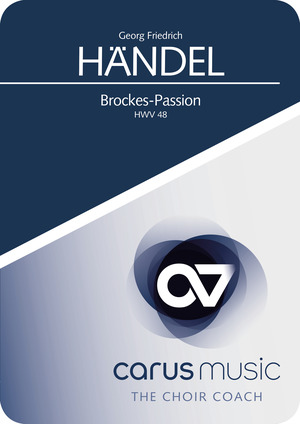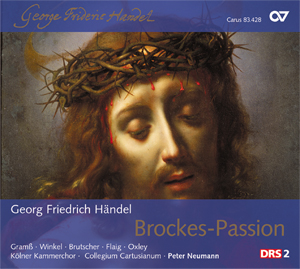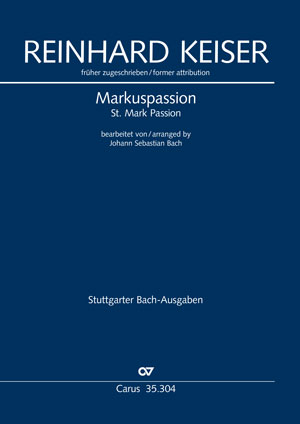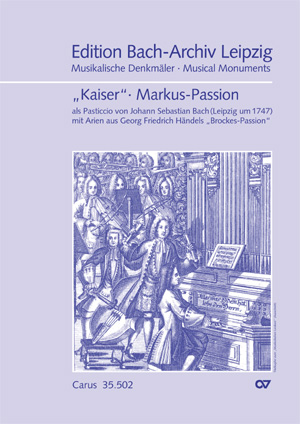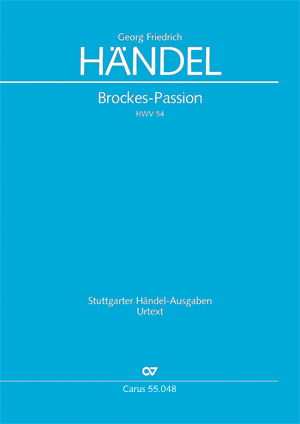
Georg Friedrich Händel Brockes-Passion. »Der für die Sünde der Welt gemarterte und sterbende Jesu«
based on the copy by J. S. Bach HWV 48
- Scoring:
- Soli STB, Soliloquenten, Coro SATB, 2 Ob, Tl, 2 Vl, Va, Bc
- Search for works with similar scoring
- Language:
- German
- Duration:
- 155 min
- Difficulty level:
- 1 2 3 4 5
 Listen
(97)
Listen
(97)
- Purchase the work as a CD or download.
- Sinfonia
- Chor: Greift zu, schlagt tot
- Rezit. (Tochter Zion): Verwegner Dorn
- Rezit. (Evang.): Und eine dicke Finsternis
- I will magnify thee
- O worship the Lord
- Glory and worship
- Tell it out amnog the heathen
- Righteousness and equity
- My mouth shall speak
- Arie (Tochter Zion): Gott selbst, der Brunnquell
- Choral: Ach, wie hungert mein Gemüte
- Rezit. (Evang., Jesus): Drauf sagten sie
- Chor: Wir alle wollen eh’ erblassen
- Rezit. (Jesus): Es ist gewiss
- Arie (Jesus): Weil ich den Hirten
- Rezit. (Petrus, Jesus): Aufs wenigste
- Arie (Jesus): Mein Vater, schau wie ich
- Rezit. (Jesus): Mich drückt der Sünden
- Arie (Jesus): Ist’s möglich, dass dein Zorn
- Arioso (Tochter Zion): Sünder, schaut mit Furcht
- Rezit. (Evang.): Die Pein vermehrte sich
- Arie (Tochter Zion): Brich, mein Herz
- Rezit. (Evang.): Ein Engel aber kam
- Arioso (Jesus, Petrus u.a.): Erwachet doch!
- Rezit. (Evang.): Und eh’ die Rede
- Rezit. (Evang., Judas): Und der Verräter
- Chor: Er soll uns nicht entlaufen
- Rezit. (Judas, Jesus): Nimm, Rabbi
- Arie (Petrus): Gift und Glut, Strahl und Flut
- Rezit. (Jesus): Steck nur das Schwert
- Chor: O weh, sie binden ihn
- Rezit. (Petrus): Wo flieht ihr hin?
- Arie (Petrus): Nehmt mich mit
- Rezit. (Evang., Jesus u.a.): Und Jesus ward
- Arie (Tochter Zion): Was Bärentatzen
- Rezit. (Evang., Petrus u.a.): Dies sahe Petrus
- Arioso (Petrus): Ich will versinken
- Rezit. (Evang., Petrus): Drauf krähete der Hahn
- Arie (Petrus): Heul, du Schaum
- Rezit. (Petrus): Doch wie will ich verzweifelnd
- Arie (Petrus): Schau, ich fall’ in strenger Buße
- Choral: Ach, Gott und Herr
- Rezit. (Evang., Jesus u.a.): Als Jesus nun
- Arie (Gläubige Seele): Erwäg, ergrimmte
- Rezit. (Evang., Tochter Zion): Die Nacht
- Arie (Tochter Zion): Meine Laster sind die Stricke
- Rezit. (Judas): O was hab’ ich
- Arie (Judas): Lasst diese Tat nicht ungerochen
- Rezit. (Judas): Unsäglich ist mein Schmerz
- Arie (Tochter Zion): Die ihr Gottes Gnad’
- Rezit. (Evang., Jesus): Wie nun Pilatus
- Chor, Rezit. (Evang., Pilatus): Bestrafe diesen
- Duett (Tochter Zion, Jesus): Sprichst du denn
- Rezit. (Evang., Pilatus u.a.): Pilatus wunderte sich
- Rezit. (Evang.): Wie er nun sah
- Rezit. (Tochter Zion): Besinne dich, Pilatus
- Rezit. (Evang.): Drauf zerreten
- Arioso (Gläubige Seele): Ich seh’ an einen Stein
- Rezit. (Gläubige Seele): Drum, Seele, schau
- Arie (Gläubige Seele): Dem Himmel gleicht
- Rezit. (Evang.): Wie nun das Blut als Strome
- Arie (Tochter Zion): Die Rosen krönen
- Arie (Tochter Zion): Lass doch
- Rezit. (Tochter Zion): Die zarten Schläfen
- Arie (Tochter Zion): Jesu! Dich mit unsern Seelen
- Rezit. (Evang., Chor): Drauf beugten sie
- Rezit., Arie (Evang., Tochter Zion): Ja, scheueten
- Rezit. (Evang.): Worauf sie mit dem Rohr
- Rezit. (Tochter Zion): Bestürzter Sünder
- Arie (Tochter Zion): Heil der Welt
- Rezit. (Evang.): Wie man ihm nun genug
- Arie (Tochter Zion, Chor): Eilt, ihr angefochtnen
- Rezit. (Maria): Ach Gott, mein Sohn
- Duett (Maria, Jesus): Soll mein Kind
- Rezit. (Evang., Tochter Zion): Und er trug
- Arie (Tochter Zion): Es scheint
- Rezit. (Evang.): Wie sie nun an die Stätte
- Arie (Gläubige Seele): Hier erstarrt mein Herz
- Rezit. (Gläubige Seele): O Anblick
- Choral: O Menschenkind, nur deine Sünd’
- Rezit. (Evang., Chor): Sobald er nun gekreuzigt
- Arie (Gläubige Seele): Was Wunder
- Rezit. (Evang.): Dies war zur neunten Stund’
- Arioso (Gläubige Seele): Mein Heiland
- Rezit. (Evang.): Drauf lief ein Kriegsknecht
- Terzett (Gläubige Seelen): O Donnerwort!
- Rezit. (Gläubige Seele, Evang.): O selig
- Arie (Tochter Zion u.a.): Sind meiner Seelen
- Rezit. (Tochter Zion, Evang.): O Großmut!
- Arie (Gläubige Seele): Brich, brüllender Abgrund
- Rezit. (Gläubige Seele u.a.): Ja, ja, es brüllet schon
- Arie (Gläubige Seele): Wie kommt’s
- Accomp. (Gläubige Seele): Bei Jesus’ Tod
- Choral: Mein’ Sünd’ mich werden kränken
- Arie (Tochter Zion): Wisch ab der Tränen
- Choral: Ich bin ein Glied an deinem Leib
 Additional material
Additional material
- Purchase additional material as a download product.
-
 text (without music) for download, html file, Singing text, english translationhtml file, Singing text, english translation (Sample)
text (without music) for download, html file, Singing text, english translationhtml file, Singing text, english translation (Sample)Sinfonia
1. Soli and Chorus (Chorus of Believers)
Come, ye cast out sinners,
death’s children, behold, here life doth end.
Your death with him shall die,
his ruin be your salvation.2a. Recitative (Evangelist)
When Jesus sat down at the table
and with his disciples was eating the Easter lamb,
the symbol of his death,
he took the bread,
and gave thanks to the Highest and broke it,
gave it to them and said:2b. Accompagnato (Jesus)
This is my body, take and eat it;
so you will not forget me.3. Aria (Daughter of Zion)
God, for whom the infinite heavens,
and all space as space is too small,
is present here, in an unfathomable way,
... -
 text (without music) for download, html file, Singing text, originalhtml file, Singing text, original (Sample)
text (without music) for download, html file, Singing text, originalhtml file, Singing text, original (Sample)Sinfonia
1. Soli und Chor (Chor der gläubigen Seelen)
Kommet, ihr verworfnen Sünder,
Todeskinder, seht, hier stirbt das Leben.
Euer Tod soll mit ihm sterben,
sein Verderben wird euch Rettung geben.2a. Rezitativ (Evangelist)
Als Jesus nun zu Tische saß,
und er das Osterlamm, das Bild von seinem Tod,
mit seinen Jüngern aß,
nahm er das Brot,
und wie er es, dem Höchsten dankend brach,
gab er es ihnen hin, und sprach:2b. Accompagnato (Jesus)
Das ist mein Leib: Kommt, nehmet, esset,
damit ihr meiner nicht vergesset.... -
 text (without music) for download, html file, Introductory text, Englishhtml file, Introductory text, English (Sample)
text (without music) for download, html file, Introductory text, Englishhtml file, Introductory text, English (Sample)Text from the CD Carus 83.424
Till Reininghaus
Translation: Elizabeth RobinsonBarthold Heinrich Brockes’ poem Der für die Sünde der Welt gemarterte und sterbende Jesus is one of the most influential and best-known Passion libretti of the early 18th century. For George Frideric Handel was by no means the only composer to set the text by the poet and future Hamburg city councilor Brockes. Shortly after the oratorio libretto was published in 1712 Reinhard Keiser, director of the Theater am Gänsemarkt, turned his attention to it. In 1716 Georg Philipp Telemann presented his own Brockes Passion for a Passion performance in Frankfurt; two years later, Johann Mattheson, the music director at Hamburg Cathedral, also decided to set the text. Handel’s setting, which was first performed in public on 3 April 1719 in the Refektorium of Hamburg Cathedral, therefore stands in the context of a whole series of compositions which are based
... -
 text (without music) for download, html file, Introductory text, Germanhtml file, Introductory text, German (Sample)
text (without music) for download, html file, Introductory text, Germanhtml file, Introductory text, German (Sample)Booklet-Text der CD Carus 83.424
Till Reininghaus
Barthold Heinrich Brockes’ Dichtung Der für die Sünde der Welt gemarterte und sterbende Jesus gehört zu den einflussreichsten und bekanntesten Passionslibretti des frühen 18. Jahrhunderts. Denn Georg Friedrich Händel war keineswegs der einzige, der den Text des Dichters und späteren Hamburger Ratsherrn Brockes vertonte. Bereits kurz nach Erscheinen des Oratorienlibrettos 1712 hatte sich der Direktor des Theaters am Gänsemarkt Reinhard Keiser der Dichtung angenommen. 1716 legte Georg Philipp Telemann für eine Frankfurter Passionsaufführung eine eigene Brockes-Passion vor; zwei Jahre später entschied sich der Hamburger Domkantor Johann Mattheson ebenfalls für den Text. Händels Vertonung, die am 3. April 1719 erstmals öffentlich im Refektorium des Hamburger Doms unter Matthesons Leitung erklang, steht somit174 im Kontext einer ganzen Reihe von Kompositionen,
...
Contents
-
Composer
Georg Friedrich Händel
| 1685-1759George Frideric Handel put his exceptionally versatile compositional abilities to the test at an early age. After moving to London in 1712, where he was appointed Composer of Musick for His Majesty’s Chapel Royal in 1723, he wrote numerous masterpieces for the royal court as well as his major opere serie. For many years he enjoyed triumphant successes with his operas, which were sung by outstanding performers, with serenades, and later also with oratorios such as Saul and Israel in Egypt. Over the years Handel’s reputation grew far beyond the city where he worked; some of his choral works, particularly Messiah, have enjoyed a performance tradition which remains unbroken to this day, and are sung by choirs throughout the world. Personal details
-
Editor
Andreas Traub
Reviews
Singende Kirche, 03/09
Reviews on our website can only be submitted by customers with a registered user account. A check whether the rated products were actually purchased does not take place.
Frequent questions about this work
 There are no questions and answers available so far or you were unable to find an answer to your specific question about this work? Then click here and send your specific questions to our Customer Services!
There are no questions and answers available so far or you were unable to find an answer to your specific question about this work? Then click here and send your specific questions to our Customer Services!


